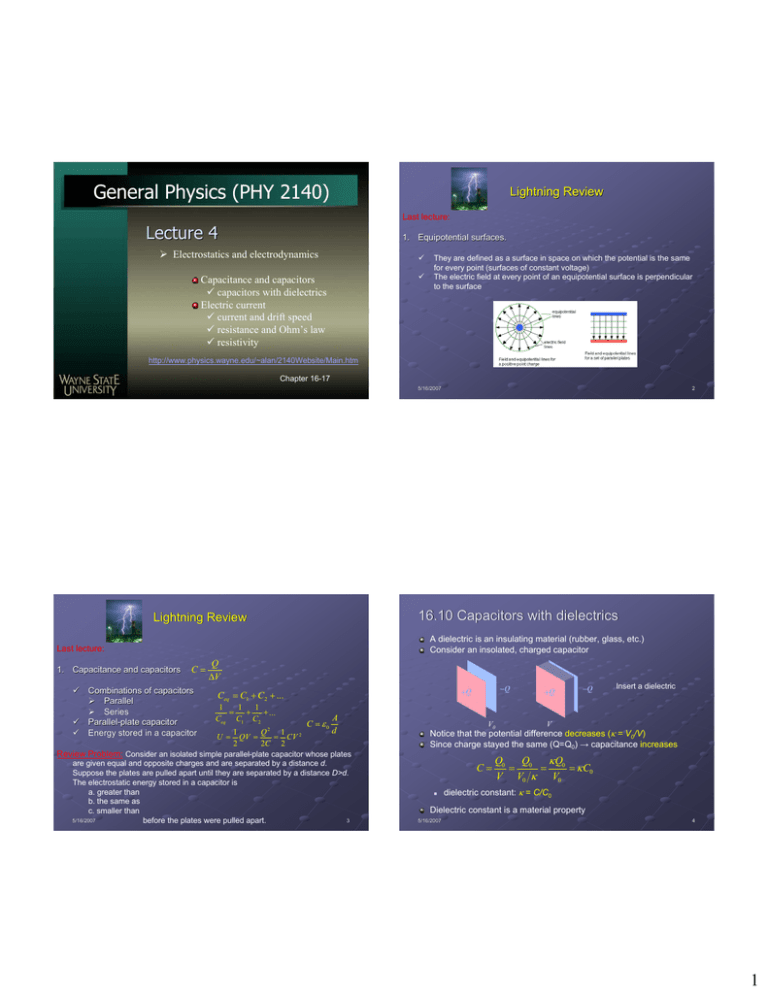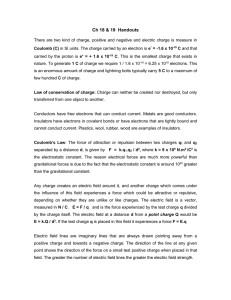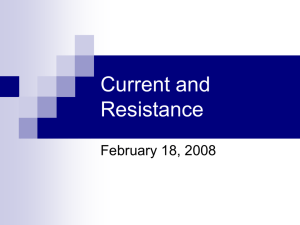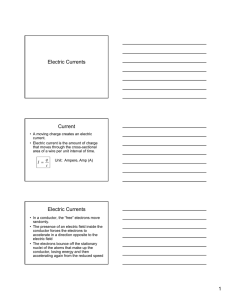4 slides per page() - Wayne State University Physics and
advertisement

General Physics (PHY 2140) Lightning Review Last lecture: Lecture 4 1. Equipotential surfaces. ¾ Electrostatics and electrodynamics 9 9 Capacitance and capacitors 9 capacitors with dielectrics Electric current 9 current and drift speed 9 resistance and Ohm’s law 9 resistivity They are defined as a surface in space on which the potential is the same for every point (surfaces of constant voltage) The electric field at every point of an equipotential surface is perpendicular to the surface http://www.physics.wayne.edu/~alan/2140Website/Main.htm Chapter 16-17 5/16/2007 1 2 16.10 Capacitors with dielectrics Lightning Review A dielectric is an insulating material (rubber, glass, etc.) Consider an insolated, charged capacitor Last lecture: 1. Capacitance and capacitors 5/16/2007 C= 9 Combinations of capacitors ¾ Parallel ¾ Series 9 ParallelParallel-plate capacitor 9 Energy stored in a capacitor Q ΔV 1 1 1 = + + ... Ceq C1 C2 −Q +Q Ceq = C1 + C2 + ... C = ε0 A d 1 Q2 1 U = QV = = CV 2 2 2C 2 Review Problem: Consider an isolated simple parallel-plate capacitor whose plates are given equal and opposite charges and are separated by a distance d. Suppose the plates are pulled apart until they are separated by a distance D>d. The electrostatic energy stored in a capacitor is a. greater than b. the same as c. smaller than 5/16/2007 3 before the plates were pulled apart. V0 +Q −Q Insert a dielectric V Notice that the potential difference decreases (κ = V0/V) Since charge stayed the same (Q=Q0) → capacitance increases C= Q0 Q κQ = 0 = 0 = κ C0 V V0 κ V0 dielectric constant: κ = C/C0 Dielectric constant is a material property 5/16/2007 4 1 Capacitors with dielectrics - notes Dielectric constants and dielectric strengths of various materials at room temperature Capacitance is multiplied by a factor k when the dielectric fills the region between the plates completely E.g., for a parallelparallel-plate capacitor A C = κε 0 d Material Vacuum Air The capacitance is limited from above by the electric discharge that can occur through the dielectric material separating the plates In other words, there exists a maximum of the electric field, sometimes called dielectric strength, strength, that can be produced in the dielectric before it breaks down 5/16/2007 Water Fused quartz Dielectric strength (V/m) 1.00 -- 1.00059 3 ×106 80 1.5 ×107 * 3.78 9 ×106 For a more complete list, see Table 16.1 * For short duration (μsec) pulses 5 Example Take a parallel plate capacitor whose plates have an area of 2.0 m2 and are separated by a distance of 1mm. The capacitor is charged to an initial voltage of 3 kV and then disconnected from the charging source. An insulating material is placed between the plates, completely filling the space, resulting in a decrease in the capacitors voltage to 1 kV. Determine the original and new capacitance, the charge on the capacitor, and the dielectric constant of the material. 5/16/2007 Given: ΔV1=3,000 V ΔV2=1,000 V A = 2.00 m2 d = 0.01 m C =? C0=? Q =? κ =? 7 6 Take a parallel plate capacitor whose plates have an area of 2 m2 and are separated by a distance of 1mm. The capacitor is charged to an initial voltage of 3 kV and then disconnected from the charging source. An insulating material is placed between the plates, completely filling the space, resulting in a decrease in the capacitors voltage to 1 kV. Determine the original and new capacitance, the charge on the capacitor, and the dielectric constant of the material. Find: 5/16/2007 Dielectric constant, κ 5/16/2007 Since we are dealing with the parallel-plate capacitor, the original capacitance can be found as C0 = ε 0 A 2.00 m2 = 8.85 ×10−12 C 2 N ⋅ m2 = 18 nF d 1.00 ×10−3 m ( ) The dielectric constant and the new capacitance are C = κ C0 = ΔV1 C0 = 3 ⋅18nF = 54nF ΔV2 The charge on the capacitor can be found to be ( ) Q = C0 ΔV = 18 ×10−9 F ( 3000V ) = 5.4 ×10−5 C 8 2 + −+ − − + −+ −+ − −+ −+ −+ −+ −+ −+ −+ −+ −+ + −+ −+ −+ −+ −+ −+ −+ −+ −+ −+ −+ −+ −+ How does an insulating dielectric material reduce electric fields by producing effective surface charge densities? Reorientation of polar molecules −+ −+ −+ −+ 17.1 Electric Current Whenever charges of like signs move in a given direction, a current is said to exist. Consider charges are moving perpendicularly to a surface of area A. Definition: the current is the rate at which charge flows through this surface. surface. Induced polarization of non-polar molecules − + − + − + − + − + − + − + − + − + − + − + − + − + − + − + − + + + Dielectric Breakdown: breaking of molecular bonds/ionization of molecules. 5/16/2007 9 17.1 Electric Current - Definition + A I 5/16/2007 10 17.1 Electric Current - Units Given an amount of charge, ΔQ, passing through the area A in a time interval Δt, the current is the ratio of the charge to the time interval. I= + + The SI units of current is the ampere (A). (A). ΔQ Δt 1 A = 1 C/s 1 A of current is equivalent to 1 C of charge passing through the the area in a time interval of 1 s. + + + + + A I 5/16/2007 11 5/16/2007 12 3 17.1 Electric Current – Remark 1 17.1 Electric Current – Remark 2 Currents may be carried by the motion of positive or negative charges. charges. It is conventional to give the current the same direction as the flow of positive charge. In a metal conductor such as copper, the current is due to the motion of the electrons (negatively charged). The direction of the current in copper is thus opposite the direction of the electrons. electrons. - - - - v I 5/16/2007 13 17.1 Electric Current – Remark 3 14 17.1 Electric Current – Remark 4 In a beam of protons at a particle accelerator (such as RHIC at Brookhaven national laboratory), the current is the same direction as the motion of the protons. In gases (plasmas) and electrolytes (e.g. Car batteries), the current is the flow of both positive and negative charges. 5/16/2007 5/16/2007 It is common to refer to a moving charge as a mobile charge carrier. carrier. In a metal the charge carriers are electrons. In other conditions or materials, they may be positive or negative ions. 15 5/16/2007 16 4 17.1 Electric Current – Example Current in a light bulb The amount of charge that passes through the filament of a certain light bulb in 2.00 s is 1.67 c. Find. (A) the current in the light bulb. The amount of charge that passes through the filament of a certain light bulb in 2.00 s is 1.67 c. Find. (A) the current in the light bulb. (B) the number of electrons that pass through the filament in 1 second. 5/16/2007 I= 17 The amount of charge that passes through the filament of a certain certain light bulb in 2.00 s is 1.67 c. Find. 5/16/2007 18 The amount of charge that passes through the filament of a certain certain light bulb in 2.00 s is 1.67 c. Find. (b) the number of electrons that pass through the filament in 1 second. (b) the number of electrons that pass through the filament in 1 second. Solution: Reasoning: In 1 s, 0.835 C of charge passes the crosscross-sectional area of the filament. This total charge per second is equal to the number of electrons, N, times the charge on a single electron. 5/16/2007 ΔQ 1.67C = = 0.835 A Δt 2.00 s ( ) N q = N 1.60 ×10−19 C / electron = 0.835C 0.835C 1.60 ×10−19 C / electron N = 5.22 ×1018 electrons N= 19 5/16/2007 20 5 17.2 Current and Drift Speed 17.2 Current and Drift Speed (2) Consider the current on a conductor of crosscross-sectional area A. A q Volume of an element of length Δx is : ΔV = A Δx. Let n be the number of carriers per unit of volume. The total number of carriers in ΔV is: n A Δx. The charge in this volume is: ΔQ = (n A Δx)q. x)q. Distance traveled at drift speed vd by carrier in time Δt: Δx = vd Δt. Hence: ΔQ = (n A vd Δt)q. The current through the conductor: vd Δx = vdΔt I = ΔQ/ Δt = n A vd q. 5/16/2007 21 22 17.2 Current and Drift Speed - Example 17.2 Current and Drift Speed (3) • In an isolated conductor, charge carriers move randomly in all directions. • When an external potential is applied across the conductor, it creates an electric field inside which produces a force on the electron. • Electrons however still have quite a random path. • As they travel through the material, electrons collide with other electrons, and nuclei, thereby losing or gaining energy. • The work done by the field exceeds the loss by collisions. • The electrons then tend to drift preferentially in one direction. 5/16/2007 5/16/2007 23 Question: A copper wire of crosscross-sectional area 3.00x10-6 m2 carries a current of 10. A. Assuming that each copper atom contributes one free electron electron to the metal, find the drift speed of the electron in this wire. The The density of 3 copper is 8.95 g/cm . 5/16/2007 24 6 Question: A copper wire of cross-sectional area 3.00x10-6 m2 carries a current of 10 A. Assuming that each copper atom contributes one free electron to the metal, find the drift speed of the electron in this wire. The density of copper is 8.95 g/cm3. Question: A copper wire of cross-sectional area 3.00x10-6 m2 carries a current of 10 A. Assuming that each copper atom contributes one free electron to the metal, find the drift speed of the electron in this wire. The density of copper is 8.95 g/cm3. Ingredients: A = 3.00x10-6 m2 ; I = 10 A.; ρ = 8.95 g/cm3.; q = 1.6 x 10-19 C. Reasoning: We know: • A = 3.00x10-6 m2 • I = 10 A. • ρ = 8.95 g/cm3. • q = 1.6 x 10-19 C. • n = 6.02x1023 atom/mol x 8.95 g/cm3 x ( 63.5 g/mol)-1 • n = 8.48 x 1022 electrons/ cm3. 5/16/2007 . I 10.0C / s vd = = nqA 8.48 ×1028 electrons m3 1.6 ×10−19 C 3.00 ×10−6 m2 n = 8.48 x 1022 electrons/cm3 = 8.48 x 1028 electrons/m3 ( 25 5/16/2007 26 Consider a wire has a long conical shape. How does the velocity of the electrons vary along the wire? Electrons traveling at 2.46x10-4 m/s would would take 68 min to travel 1m. So why does light turn on so quickly when one flips a switch? 5/16/2007 ) MiniMini-quiz Drift speeds are usually very small. Drift speed much smaller than the average speed between collisions. )( = 2.46 ×10 m / s 17.2 Current and Drift Speed - Comments )( −4 Every portion of the wire carries the same current: as the cross sectional area decreases, the drift velocity must increase to carry the same value of current. This is dues to the electrical field lines being compressed into a smaller area, thereby increasing the strength of the electric field. The info travels at roughly 108 m/s… m/s… 27 5/16/2007 28 7 17.4 Resistance and Ohm’ Ohm’s Law - Intro 17.4 Definition of Resistance When a voltage (potential difference) is applied across the ends of a metallic conductor, the current is found to be proportional to the applied voltage. In situations where the proportionality is exact, one can write. ΔV = IR I ∝ ΔV • The proportionality constant R is called resistance of the conductor. • The resistance is defined as the ratio. ΔV R= ΔV I I 5/16/2007 29 17.4 Resistance - Units 5/16/2007 30 17.4 Ohm’ Ohm’s Law In SI, resistance is expressed in volts per ampere. A special name is given: ohms (Ω (Ω). Resistance in a conductor arises because of collisions between electrons and fixed charges within the material. In many materials, including most metals, the resistance is constant over a wide range of applied voltages. This is a statement of Ohm’ Ohm’s law. Example: if a potential difference of 10 V applied across a conductor produces a 0.2 A current, then one concludes the conductors has a resistance of 10 V / 0.2 A = 50 Ω. Georg Simon Ohm (1787-1854) 5/16/2007 31 5/16/2007 32 8 Linear or Ohmic Material Ohm’s Law Non-Linear or Non-Ohmic Material I ΔV = IR I R understood to be independent of ΔV. ΔV ΔV Most metals, ceramics Semiconductors e.g. diodes 5/16/2007 33 5/16/2007 34 Example: Resistance of a Steam Iron Definition: Resistor: a conductor that provides a specified resistance in an electric circuit. All household electric devices are required to have a specified resistance (as well as many other characteristics… characteristics…). Consider that the plate of a certain steam iron states the iron carries a current of 7.40 A when connected to a 120 V source. What is the resistance of the steam iron? The symbol for a resistor in circuit diagrams. V = IR I + - R= ΔV 120V = = 16.2 Ω 7.40 A I E 5/16/2007 35 5/16/2007 36 9 17.5 Resistivity - Intro 17.5 Resistivity - Definition Electrons moving inside a conductor subject to an external potential constantly collide with atoms of the conductor. They lose energy and are repeated rere-accelerated by the electric field produced by the external potential. The collision process is equivalent to an internal friction. This is the origin of a material’ material’s resistance. resistance. 5/16/2007 37 17.5 Resistivity - Remarks The resistance of an ohmic conductor is proportional to the its length, l, and inversely proportional to the cross section area, A, of the conductor. l A • The constant of proportionality ρ is called the resistivity of the material. R=ρ 5/16/2007 17.5 Resistivity - Units Every material has a characteristic resistivity that depends on its electronic structure, and the temperature. Good conductors have low resistivity. resistivity. Insulators have high resistivity. resistivity. R=ρ 39 l A ρ= RA l Resistance expressed in Ohms, Length in meter. Area are m2, Resistivity thus has units of Ωm. Analogy to the flow of water through a pipe. 5/16/2007 38 5/16/2007 40 10 Resistivity of various materials (also see table 17.1) Material Resistivity (10-8 Ωm) Material Resistivity (10-8 Ωm) Silver Copper Gold Aluminum 1.61 1.70 2.20 2.65 Bismuth Plutonium Graphite Germanium 106.8 141.4 1375 4.6x107 Pure Silicon Calcium 3.5 Diamond 2.7x109 3.91 1.8x1013 Sodium Tungsten Brass Uranium Mercury 4.75 5.3 7.0 30.0 98.4 Deionized water Iodine Phosphorus Quartz Alumina Sulfur 41 17.5 Resistivity - Example ( 5/16/2007 (b) If a potential difference of 10.0 V is maintained across a 1.0-m length of the nichrome wire, what is the current? ) 2 A = πr2 = π 0.321×10−3 m = 3.24×10−7 m2 I= Resistivity (Table): 1.5 x 10−6 Ωm. Resistance/unit length: 5/16/2007 42 17.5 Resistivity - Example (a) Calculate the resistance per unit length of a 22-gauge nichrome wire of radius 0.321 m. Cross section: Why do old light bulbs give less light than when new? Answer: • The filament of a light bulb, made of tungsten, is kept at high temperature when the light bulb is on. • It tends to evaporate, i.e. to become thinner, thus decreasing in radius, and cross sectional area. • Its resistance increases with time. • The current going though the filament then decreases with time – and so does its luminosity. • Tungsten atoms evaporate off the filament and end up on the inner surface of the bulb. • Over time, the glass becomes less transparent and therefore less luminous. 1.3x1015 1x1017 1x1021 1x1022 2x1023 5/16/2007 MiniMini-quiz ΔV 10.0V = = 2.2 A 4.6Ω R R ρ 1.5 ×10−6 Ωm = = = 4.6 Ω m l A 3.24 ×10−7 m2 43 5/16/2007 44 11 17.6 Temperature Variation of Resistance - Intro . . . next lecture • The resistivity of a metal depends on many (environmental) factors. • The most important factor is the temperature. • For most metals, the resistivity increases with increasing temperature. • The increased resistivity arises because of larger friction caused by the more violent motion of the atoms of the metal. 5/16/2007 45 12





